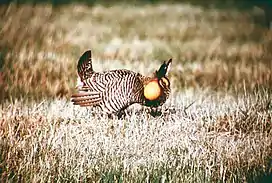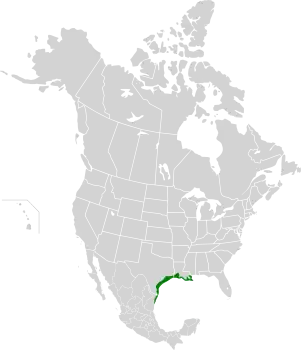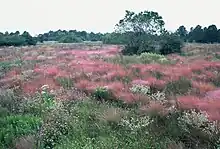Western Gulf coastal grasslands
The Western Gulf coastal grasslands (Spanish: Pastizales costeros del Golfo Occidental) are a subtropical grassland ecoregion of the southern United States and northeastern Mexico. It is known in Louisiana as the "Cajun Prairie", Texas as "Coastal Prairie," and as the Tamaulipan pastizal (Spanish: Pastizal Tamaulipeco) in Mexico.
| Western Gulf coastal grasslands Tamaulipan pastizal | |
|---|---|
 | |
 | |
| Ecology | |
| Realm | Nearctic |
| Biome | Tropical and subtropical grasslands, savannas, and shrublands |
| Borders | |
| Bird species | 335[1] |
| Mammal species | 75[1] |
| Geography | |
| Area | 77,425 km2 (29,894 sq mi) |
| Countries | |
| States | |
| Climate type | Humid subtropical |
| Conservation | |
| Habitat loss | 48.734%[1] |
| Protected | 10.31%[1] |
Setting

The ecoregion covers an area of 77,425 km2 (29,894 sq mi), extending along the shore of the Gulf of Mexico from southeastern Louisiana (west of the Mississippi Delta) through Texas and into the Mexican state of Tamaulipas as far as the Laguna Madre. Specific areas include a number of barrier islands, and the resacas or natural levees of the Laguna Madre.[2] The coast is vulnerable to tropical storms that can seriously damage habitats.[3]
This ecosystem, in part, has edaphic origins: the soils of this ecoregion are largely dominated by vertisol clays, the mechanical properties of which make it difficult for many tree species to grow and establish. As a result, extensive forest cover is precluded, allowing grasses and other herbaceous species to dominate.[4] However, there are interspersed areas of higher sand and silt content that break up the otherwise heavy clay environment: these areas typically correspond to floodplain/riparian zones, and are more permissive of tree-growth, featuring galleries or even closed-canopy bottomland expanses.[5]
Climate
From Southwest Louisiana west to the Upper Texas coast, the climate is wet humid subtropical, featuring significal annual precipitation. The climate becomes more arid farther south along the Texas coast into northeastern Mexico, though precipitation totals still remain high enough for the humid subtropical classification.
Flora
The natural habitat of the area is a mix of tallgrass prairie similar to those found in inland Texas, with Indiangrass (Sorghastrum nutans), big bluestem (Andropogon gerardi), little bluestem (Schizachyrium scoparium), and switchgrass (Panicum virgatum) the primary tallgrass species that are typical of the coastal prairie, with several other shorter grasses and many herbaceous and woody species.
Separating the grassier habitats are bottomland forests and woodlands, which are present within the floodplains of the region's many waterways. In the wetter climate covering the zone from Southwest Louisiana west through the upper Texas coast, these bottomlands contain many species typical in forests elsewhere across the Southern United States, such as the southern live oak, bald cypress, magnolia, loblolly pine, post oak, and southern hackberry. Farther south, from the lower one third of the Texas coast and through the Tamaulipan stretch, the drier climate supports shrubby areas of honey mesquite (Prosopis glandulosa), huisache (Vachellia farnesiana var. farnesiana), lime prickly-ash (Zanthoxylum fagara), and Texas persimmon (Diospyros texana).[2]
Fauna
This coast is rich in wildlife, and 700 species of birds, animals and reptiles have been counted here, although many are now threatened or endangered. This coast is a critical habitat for the Attwater's prairie chickens (Tympanuchus cupido attwateri), over one million of which inhabited the prairie in Texas and Louisiana in the 19th century, but extreme reduction of their habitat put them on the U.S. endangered species list in 1967. Another endangered bird of the coast is the whooping crane (Grus americana). Many species of wading birds, shorebirds, and other waterbirds are abundant. Birds in the Mexican part of the region include Morelet’s seedeater (Sporophila morelleti), red-billed pigeon (Columba flavirostris), brown jay (Cyanocorax morio), Neotropic cormorant, white-winged dove (Leptotila verrequxi) and Audubon's oriole (Icterus graduacauda).
Mammals of the area include bobcats, collared peccary, white-tailed deer, eastern cottontails, with ocelot (Leopardus pardalis), Gulf Coast jaguarundi (Puma yagouaroundi cacomitli), southern yellow bat (Lasiurus ega), and Mexican spiny pocket mouse (Liomys irroratus) more abundant in Mexico. Rancho Nuevo beach in Tamaulipas and along the Texas coast are the only nesting sites in the world for the Kemp's ridley sea turtle (Lepidochelys kempii) while other herpetofauna of the southern part of the ecoregion include Río Grande chirping frog (Eleutherodactylus cystignathoides) and Mexican white-lipped frog (Leptodactylus fragilis).
Threats and preservation
Less than 1% of the ecoregion remains in pristine condition, almost entirely in Texas, while most of the coast has been converted to farmland, including rice paddies, grazing land, or urban areas including Houston, Texas. Estuaries and other coastal wetlands are better preserved than the prairie and indeed the protected areas of the coast are mainly sanctuaries for waterbirds.
Gallery
.jpg.webp) McFaddin National Wildlife Refuge, Jefferson County, Texas, USA (30 April 2010).
McFaddin National Wildlife Refuge, Jefferson County, Texas, USA (30 April 2010)..jpg.webp) Marysee Prairie Preserve, County Road 2077, Liberty County, Texas, USA (22 May 2020).
Marysee Prairie Preserve, County Road 2077, Liberty County, Texas, USA (22 May 2020)._Chambers_Co._TX%253B_1_Dec_2018.jpg.webp) Anahuac National Wildlife Refuge, Chambers County, Texas, USA (1 December 2018).
Anahuac National Wildlife Refuge, Chambers County, Texas, USA (1 December 2018).%252C_Attwater_Prairie_Chicken_National_Wildlife_Refuge%252C_Colorado_County%252C_Texas%252C_USA_(29_March_2019).jpg.webp) Texas bluebonnets (Lupinus texensis), Attwater Prairie Chicken National Wildlife Refuge, Colorado County, Texas, USA (29 March 2019).
Texas bluebonnets (Lupinus texensis), Attwater Prairie Chicken National Wildlife Refuge, Colorado County, Texas, USA (29 March 2019)..jpg.webp) Texas bullnettle & plains coreopsis, Attwater Prairie Chicken National Wildlife Refuge, Colorado Co., TX, USA (3 May 2018).
Texas bullnettle & plains coreopsis, Attwater Prairie Chicken National Wildlife Refuge, Colorado Co., TX, USA (3 May 2018).%252C_Attwater_Prairie_Chicken_National_Wildlife_Refuge%252C_Colorado_County%252C_Texas%252C_USA_(24_May_2014).jpg.webp) Crested caracara (Caracara plancus) Attwater Prairie Chicken National Wildlife Refuge, Colorado County, Texas, USA (24 May 2014).
Crested caracara (Caracara plancus) Attwater Prairie Chicken National Wildlife Refuge, Colorado County, Texas, USA (24 May 2014)..jpg.webp) Attwater Prairie Chicken National Wildlife Refuge, Colorado County, Texas, USA (11 November 2017).
Attwater Prairie Chicken National Wildlife Refuge, Colorado County, Texas, USA (11 November 2017)..jpg.webp) Brazos Bend State Park, Fort Bend County, Texas, USA (8 December 2010).
Brazos Bend State Park, Fort Bend County, Texas, USA (8 December 2010).%252C_Brazoria_National_Wildlife_Refuge%252C_Brazoria_County%252C_Texas%252C_USA_(24_August_2013).jpg.webp) Saltmarsh fleabane (Pluchea odorata), Brazoria National Wildlife Refuge, Brazoria County, Texas, USA (24 August 2013).
Saltmarsh fleabane (Pluchea odorata), Brazoria National Wildlife Refuge, Brazoria County, Texas, USA (24 August 2013)..jpg.webp) San Bernard National Wildlife Refuge, Brazoria County, Texas, USA (12 December 2016).
San Bernard National Wildlife Refuge, Brazoria County, Texas, USA (12 December 2016)..jpg.webp) Aransas National Wildlife Refuge, Aransas County, Texas, USA (27 November 2011).
Aransas National Wildlife Refuge, Aransas County, Texas, USA (27 November 2011)..jpg.webp) Padre Island National Seashore, Kleberg County, Texas, USA (26 November 2011).
Padre Island National Seashore, Kleberg County, Texas, USA (26 November 2011).%252C_Laguna_Atascosa_National_Wildlife_Refuge%252C_Cameron_County%252C_Texas%252C_USA_(12_April_2016).jpg.webp) Spanish Dagger (Yucca treculeana), Laguna Atascosa National Wildlife Refuge, Cameron County, Texas, USA (12 April 2016).
Spanish Dagger (Yucca treculeana), Laguna Atascosa National Wildlife Refuge, Cameron County, Texas, USA (12 April 2016)._on_the_road_to_Mezquital%252C_Municipality_of_Matamoros%252C_Tamaulipas%252C_Mexico_(18_March_2009).jpg.webp) Harris's Hawk (Parabuteo unicinctus) on the road to Mezquital, Municipality of Matamoros, Tamaulipas, Mexico (18 March 2009).
Harris's Hawk (Parabuteo unicinctus) on the road to Mezquital, Municipality of Matamoros, Tamaulipas, Mexico (18 March 2009)..jpg.webp) Grassland habitat on the road to Mezquital, Municipality of Matamoros, Tamaulipas, Mexico (18 March 2009).
Grassland habitat on the road to Mezquital, Municipality of Matamoros, Tamaulipas, Mexico (18 March 2009).
References
- Hoekstra, J. M.; Molnar, J. L.; Jennings, M.; Revenga, C.; Spalding, M. D.; Boucher, T. M.; Robertson, J. C.; Heibel, T. J.; Ellison, K. (2010). Molnar, J. L. (ed.). The Atlas of Global Conservation: Changes, Challenges, and Opportunities to Make a Difference. University of California Press. ISBN 978-0-520-26256-0.
- "Western Gulf coastal grasslands". Terrestrial Ecoregions. World Wildlife Fund. Retrieved October 20, 2010.
- "Western Gulf coastal grasslands (NA0701)". WildWorld Ecoregion Profiles. National Geographic Society. Retrieved October 20, 2010.
- "Coastal Prairie". gulfcoast.harc.edu. Archived from the original on February 25, 2013.
- "Texas Ecoregions — Texas Parks & Wildlife Department".